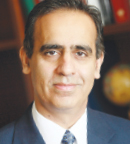Preet M. Chaudhary, MD, PhD, of the University of Southern California (USC) Keck School of Medicine, Los Angeles, commented on the HOVON-96 trial for The ASCO Post. Dr. Chaudhary is Professor and Chief of Hematology, the Ronald H. Bloom Family Chair in Lymphoma Research, and Program Director of USC/Norris Blood and Marrow Transplant Program.

Preet M. Chaudhary, MD, PhD
“HOVON-96 is a very interesting study, using posttransplantation cyclophosphamide in matched related and unrelated donors. Overall, I’m very enthusiastic about the result. It’s a step in the right direction. In fact, I think it is practice-changing,” he commented.
The Norris Comprehensive Cancer Center is already employing posttransplantation cyclophosphamide, as are some other major cancer centers. Dr. Chaudhary is using it even in patients who undergo myeloablative conditioning (patients in HOVON-96 had reduced-intensity conditioning). “We are having good luck with this, so far,” he added.
For All Patient Populations?
However, Dr. Chaudhary is concerned about extending this approach to all patient populations. “They showed that graft-vs-host disease can be reduced, but the other side of the coin is the graft-vs-leukemia effect. If patients are in deep remission and you reduce graft-vs-host disease, you don’t worry much about [compromising] the graft-vs-leukemia effect. You can reduce graft-vs-host disease with posttransplantation cyclophosphamide without increasing the risk of relapse.”
“But, on the other hand, if we extend this particular paradigm to a patient population not in deep remission, then the question is whether we are increasing the risk of relapse, especially after reduced-intensity conditioning, as was the case in this study (myeloablative conditioning is more likely to eliminate residual cancer). By reducing the immune response—which is what cyclophosphamide seems to be doing—then maybe the graft-vs-leukemia effect will also be reduced; and if the patient has some residual leukemia, the disease will recur,” suggested Dr. Chaudhary.
‘A Step in the Right Direction’
“Going forward, if we are going to start using this approach in all patients, we should look into this area and, meanwhile, ensure that patients are in deep remission,” Dr. Chaudhary proposed. “Overall, this is a step in the right direction, because there is too much toxicity with calcineurin inhibitors, and they require more monitoring. This is a straightforward, safer, less-expensive approach. It’s a win-win.”
DISCLOSURE: Dr. Chaudhary is a consultant for Athelas, Oncotartis, and panCELLa; and founder of Angeles Therapeutics.

